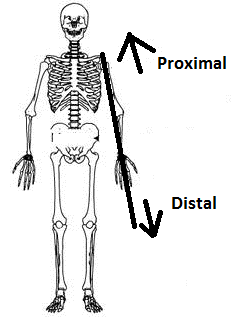It’s easy to get confused with distinguishing between proximal and distal. It’s an important concept to understand, albeit it is more commonly used and found in the medical field.
Let’s get a basic overview of what proximal and distal mean.
Proximal & Distal: Definition
Proximal and distal relate to the distance between the center of the body and another point on the body.
Merriam’s Dictionary defines proximal as something that is located near the point of origin. And defines proximal as situated away from the center of the body. Both terms are used in relationship to each other.
Put in other words, the term distal means ‘further away’ (from the center or the body); whereas proximal means ‘closest to’. The center of the body in this case is the torso or heart.
Why is this wording used?
Medically speaking, it is used anatomically in speaking about a wound in relationship to the heart as a point of reference.
Although proximal and distal are not only used in the medical field; they can be found, albeit more rarely in other sciences, to relate things vis-a-vis one another.
Proximal vs Distal: What’s the Difference?
As mentioned distal and proximal are used to designate anatomical locations. For example, with reference to a wound on the ankle, the toes are distal, and the hip is proximal.

For another example and to explain the picture above a bit better, if you have an arm that is extended you would see that your wrist is farther away than your elbow (using your heart as a point of reference) and so your wrist would be distal as its farther than your elbow, and your elbow would be proximal because it’s closer to your chest than your wrist.
Easy way to remember
One of the easiest ways to remember the distinction between proximal and distal is that proximal is similar to the word proximity (being close to something).
So if you are in proximity to something you are near it. Distal then is being furthest away from something.
Example
For example, let’s say you had a cut on your hand and it was bleeding profusely. If you were to describe where the wound is located it would be distal from your body than your wrist.
Takeaway
Does that make sense? Knowing the difference is important mostly for medical scenarios which require diagnosis and is not generally essential for survivalists, but a good thing to know nonetheless.
—
References
[1] Proximal. https://medlineplus.gov/ency/article/002287.htm
[2] Distal. https://medlineplus.gov/ency/article/002346.htm

